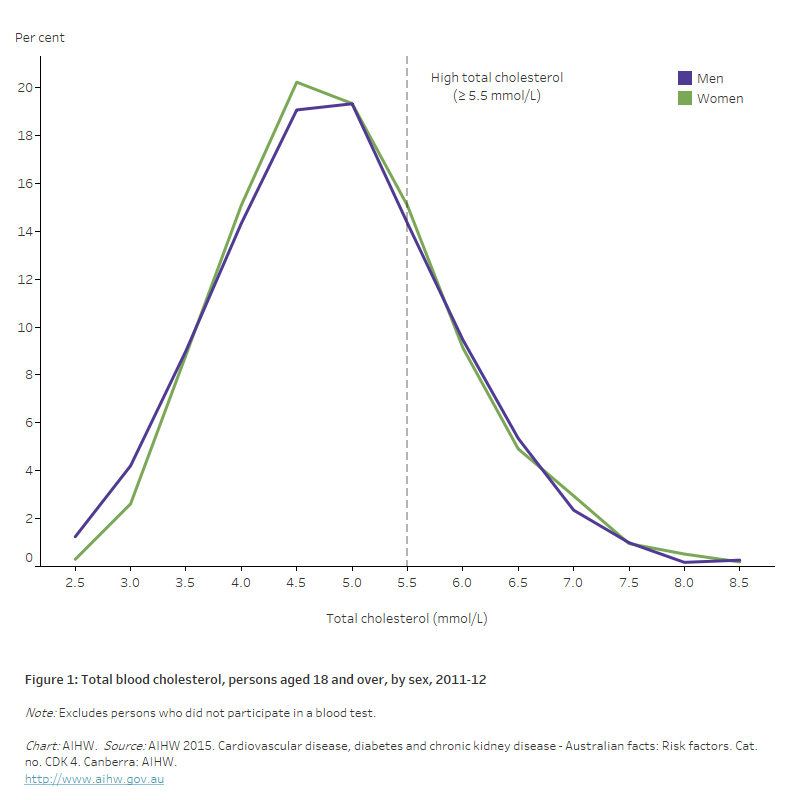Abnormal blood lipids
Abnormal levels of blood lipids, such as cholesterol and triglycerides – known as dyslipidaemia – can contribute to the development of atherosclerosis, a build-up of fatty deposits in the blood vessels. This build-up increases the risk of a number of cardiovascular diseases, including coronary heart disease, stroke and peripheral arterial disease.
Blood tests are used to determine levels of the most commonly measured lipids. The standard blood tests include measurement of total cholesterol, low-density lipoprotein cholesterol (LDL, or ‘bad’ cholesterol), high-density lipoprotein cholesterol (HDL, or ‘good’ cholesterol), as well as triglycerides.
In the ABS 2011–12 Australian Health Survey, a person had dyslipidaemia if they had one or more of the following:
- total cholesterol ≥ 5.5 mmol/L
- LDL cholesterol ≥ 3.5 mmol/L
- HDL cholesterol < 1.0 mmol/L for men, and < 1.3 mmol/L for women
- triglycerides ≥ 2.0 mmol/L
- taking lipid-modifying medication (ABS 2013).
For most people, saturated fat in the diet is the most important factor associated with dyslipidaemia. Sufficient physical activity and a healthy diet help maintain normal blood cholesterol levels. People with dyslipidaemia may also be treated with lipid-modifying medicines such as statins.
In 2011–12, based on estimates from the most recent large-scale biomedical survey of the Australian population:
- 2 in 3 Australian adults (63%, or 8.5 million) had abnormal blood lipid levels. This included 57% with uncontrolled abnormal blood lipids and 6.6% with normal blood lipid levels who were taking lipid-modifying medication (AIHW 2015)
- 33% of adults had raised levels of LDL (bad) cholesterol, 23% had low levels of HDL (good) cholesterol and 14% had raised levels of triglycerides. One-in-3 Australian adults (33%) had a total cholesterol level that was considered high (Figure 1)
- men (64%, or 4.2 million) and women (63%, or 4.3 million) had similar levels of dyslipidaemia in 2011–12
- the proportion of adults with dyslipidaemia increased with age – from 34% among 18–24 year-olds (31% men, 36% women) to a peak of 81% at age 65–74 (78% men, 84% women).
Figure 1: Total blood cholesterol, persons aged 18 and over, by sex, 2011–12
The line chart shows the distribution of total blood cholesterol levels in 2011–12, peaking at around 4.5 mmol/L for both men and women.

Population groups
- There were no statistically significant differences in the proportion of adults with dyslipidaemia across remoteness areas in 2011–12 – crude rates of 62% in Major cities, 68% in Inner regional areas and 66% in Outer regional and remote areas.
- There were no statistically significant differences in the proportion of adults with dyslipidaemia across socioeconomic areas in 2011–12 – crude rates of 67% of people living in the lowest socioeconomic areas, 61% in the highest socioeconomic areas.
References
ABS 2013. Australian Health Survey: user’s guide, 2011–13. ABS cat. no. 4363.0.55.001. Canberra: ABS.
AIHW 2015. Cardiovascular disease, diabetes and chronic kidney disease—Australian facts: Risk factors. Cat. no. CDK 4. Canberra: AIHW.


